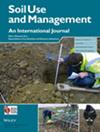通过沸石处理防止葡萄藤遭受干旱破坏:一种有前途的可持续土壤管理解决方案
IF 3.7
3区 农林科学
Q1 SOIL SCIENCE
引用次数: 0
摘要
葡萄栽培活动与气候波动有着内在的联系,并受到土壤管理的严重影响。气温升高和降水量减少会导致植物新陈代谢途径发生一些变化,从而降低葡萄的品质。土壤管理的主要目的是保持和维持一个考虑到葡萄树所有需求的微环境,以提高植株生长和果穗质量之间的平衡,增强对非生物压力的适应能力。为了确定桑娇维塞葡萄树对干旱胁迫反应的匹配性和差异性,我们在基安蒂古典葡萄园以自然暴露于非生物胁迫的植物为对照,研究了施用沸石和灌溉土壤(联合和/或单独)后生态生理和生物化学的变化。当葡萄树单独受到水分胁迫时,主要反应包括叶片正午水势下降(Ψ叶)和脯氨酸含量增加。与此同时,叶片中的玉米黄质和叶黄素含量也增加了,这是氧化应激的症状。沸石和/或水引发的葡萄新陈代谢的积极变化对浆果的成熟产生了一定的影响,具体影响因年份而异。在最温暖的季节,沸石和/或水为浆果创造了一种恢复能力,避免了花青素合成途径的停滞;在较新鲜的季节,浆果的成熟更为均衡,更接近现代经典基安蒂葡萄酒生产商的目标(即更新鲜、酒精度更低)。在严重干旱的情况下,莽草酸途径被激活,受压葡萄树(WS)的苹果酸含量减少。沸石和不干旱处理提高了糖和酚类化合物的含量。干旱和高温加上胁迫产生的负面影响是 WS 处理中槲皮素-3-O-芸香糖苷(Qrut)、槲皮素-3-O-半乳糖苷(Qgala)、槲皮素-3-O-葡萄糖苷(Qgluc)和槲皮素-3-O-葡萄糖醛酸(Qgluco)的积累。这些结果表明,在土壤中施用clinoptilolite,无论是与水混合施用还是纯施用,都能显著保护葡萄树免受干旱胁迫带来的更多不利影响,这表明新的可持续土壤管理方法对葡萄树的健康非常有用。本文章由计算机程序翻译,如有差异,请以英文原文为准。
Prevention of drought damage through zeolite treatments onVitis vinifera: A promising sustainable solution for soil management
Viticultural activity is intrinsically interlocked with climatic fluctuations and awful subjected to soil management. Increasing temperatures and reduced precipitation originate several alterations in the metabolic plant pathway and a depletion in grapes quality. The main aspiration of soil management is to keep and retain a microenvironment that considers all vine requirements to upgrade the balance between vegetative growth and cluster quality intensifying its resilience towards abiotic stress. Aiming to establish match and dissimilar drought stress responses among Sangiovese grapevines, we scouted ecophysiological and biochemical alterations after zeolite and irrigation soil application (combined and/or alone), using as control plants naturally exposed to abiotic stress in a Chianti Classico vineyard. When grapevines were exposed to water stress alone, the main reactions encompassed dwindled leaf midday water potential (Ψleaf) and increased proline content. These were accompanied by augments in zeaxanthin and lutein leaf contents, symptomatic of oxidative stress. Positive metabolic alterations in grapes triggered by zeolite and/or water showed some influence on the ripening of the berry differently depending on the year. They created a situation of resilience in berry avoiding arrest in the anthocyanin synthesis pathway during the warmest season and produced a more balanced maturation, closer to the objectives of the modern producer of classic Chianti (i.e. fresher and less alcoholic wines) during the fresher one. Under severe drought, it was activated the shikimic acid pathway and in stressed vines treatment, (WS) a reduction in malic acid content was found. Sugar and phenolic compounds were enhanced by zeolitic and undrought treatments. A negative effect enkindled by the drought and high temperatures combined with stress was the accumulation of quercetin‐3‐O‐rutinoside (Qrut), quercetin‐3‐O‐galactoside (Qgala), quercetin‐3‐O‐glucoside (Qgluc) and quercetin‐3‐O‐glucoronide (Qgluco) in WS treatment. These results summarize that clinoptilolite applied to the soil, both combined with water as well in purity, noteworthy protectorship from more detrimental repercussions of drought‐stressed grapevines, suggesting that new sustainable approaches in soil management are useful for the wellness of vines.
求助全文
通过发布文献求助,成功后即可免费获取论文全文。
去求助
来源期刊

Soil Use and Management
农林科学-土壤科学
CiteScore
7.70
自引率
13.20%
发文量
78
审稿时长
3 months
期刊介绍:
Soil Use and Management publishes in soil science, earth and environmental science, agricultural science, and engineering fields. The submitted papers should consider the underlying mechanisms governing the natural and anthropogenic processes which affect soil systems, and should inform policy makers and/or practitioners on the sustainable use and management of soil resources. Interdisciplinary studies, e.g. linking soil with climate change, biodiversity, global health, and the UN’s sustainable development goals, with strong novelty, wide implications, and unexpected outcomes are welcomed.
 求助内容:
求助内容: 应助结果提醒方式:
应助结果提醒方式:


